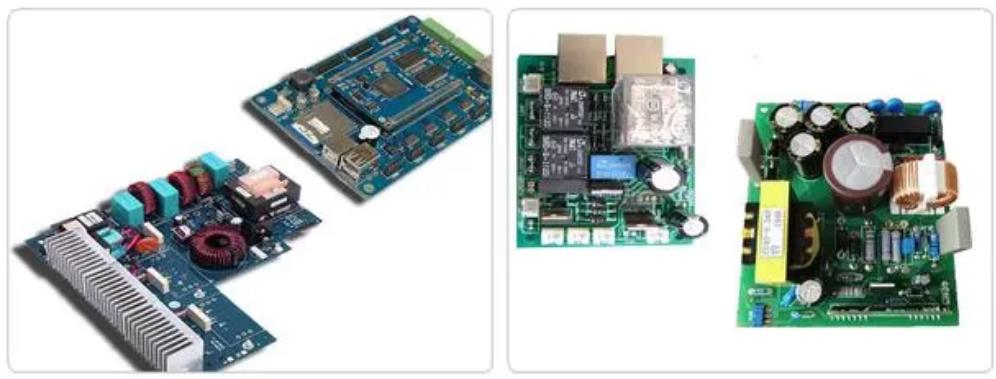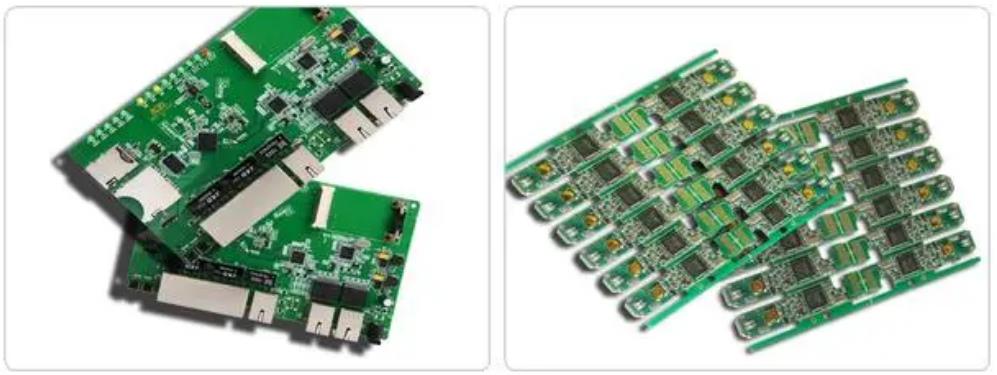Bridging
Bridging often occurs on ICs with dense pins or between chip components with small spacing. This defect is classified as a major defect in our inspection standards, and must be eliminated as it will seriously affect the electrical performance of the product.
The main reason for bridging is due to excessive solder paste or misalignment or collapse of the solder paste after printing.
Excessive Paste
Excessive solder paste is caused by improper template thickness and aperture size.Normally,we choose to use 0.15mm thickness templates. The aperture size is determined by the minimum pin or chip spacing.
Printing Misalignment
When printing boards with pin spacing or chip spacing less than 0.65mm,optical positioning should be used, with the datum point set at the diagonal of the board. If optical positioning is not used, printing misalignment will occur due to positioning errors, resulting in bridging.
Solder Paste Collapse
There are three types of solder paste collapsing phenomena as follows
1.Printing Collapse
Collapse occurs when the solder paste is printed.This has a lot to do with the characteristics of the solder paste, template, printing parameters are set: the viscosity of the solder paste is low, the conformability is not good, easy to collapse after printing, bridging; template hole wall if the roughness is not flat, printed solder paste is also prone to collapsing, bridging; too much squeegee pressure will produce a greater impact on the solder paste, the shape of the solder paste is destroyed, the probability of collapsing also greatly increased.
Countermeasures: Choose higher viscosity solder paste; use laser cutting template; reduce squeegee pressure.
2.Collapsed edge during mounting
When the placement machine in the placement of SOP, QFP type integrated circuits, the placement pressure should be set appropriately. Too much pressure will make the solder paste shape changes and collapse.
Countermeasure: Adjust the mounting pressure and set the mounting nozzle including the thickness of the component itself in the downward position of the mounting nozzle.

PCBA Products
3.Collapse during welding heating
Collapse also occurs when soldering is heated. When the circuit board components in the rapid heating, the solvent components in the solder paste will volatilise, if the volatilisation rate is too fast, the solder particles will be extruded out of the soldering area, the formation of the heated edge collapse.
Countermeasure: Set the appropriate soldering temperature curve (temperature and time) and prevent mechanical vibration of the conveyor belt.
Solder Ball
Solder balls are also a common problem in reflow soldering. Solder balls often appear on the side of a chip component or between fine-pitch pins.
Solder balls are caused by the rapid heating during the soldering process, which causes the solder to fly away. In addition to the previously mentioned printing errors, collapsed edges, but also with the paste viscosity, paste oxidation, solder particle size (fine), flux activity and so on.
1.Paste viscosity
Viscosity effect of better solder paste, its adhesive force will offset the impact of heating emissions solvent, can block the solder paste collapse.
2.Solder paste oxidation
Solder paste after contact with air, the surface of the solder particles may produce oxidation, and experimental evidence of the incidence of solder ball with the percentage of solder paste oxides salty proportional. General solder paste oxide should be controlled at about 0.03%, the maximum value should not exceed 0.15%.
3.The thickness of solder particles
The uniformity of the solder particles is inconsistent, if it contains a large number of particles below 20 μ m, the relative area of these particles is relatively large, very easy to oxidise, the most likely to form a solder ball. In addition, during the solvent evaporation process, these small particles will be easily washed away from the pad, increasing the chance of solder balls. The general requirement is that the number of particles below 25um should not exceed 5% of the total number of solder particles.
4.Solder paste moisture absorption
This situation can be divided into two categories: solder paste before use from the freezer immediately after taking out the lid, resulting in condensation of water vapour; reflow soldering before drying insufficient residual solvent, solder paste in the welding heating caused by the solvent, water spattering, spattering of solderparticles to the circuit board to form a solder ball. According to these two different situations, we can take the following two different measures:
A. Solder paste should not be opened immediately after it is taken out of the freezer, but should be rewarmed at room temperature and used with the lid open after the temperature has stabilised.
B. Adjust the reflow soldering temperature curve so that the solder paste is sufficiently preheated before soldering.
5.FLux activity
When the flux activity is low, it is also easy to produce solder balls. The activity of no-clean solder is generally slightly lower than the activity of rosin-type and water-soluble solder paste, which should be used to pay attention to the generation of solder balls.
6.Mesh Hole Opening
The proper shape and size of the template aperture will also reduce the generation of solder balls. Generally, the size of the template hole should be 10% smaller than the corresponding pad, and some template hole design is recommended.
7.Circuit board cleaning
Circuit boards need to be cleaned after printing errors, if the cleaning is not clean, the surface of the board and the hole will have residual solder paste, soldering will form solder balls. This is to strengthen the operator's sense of responsibility in the production process, in strict accordance with the requirements of the production process, and strengthen the quality control of the process.

PCBA Products
Monolithic
In the surface mounting process of reflow soldering process, the chip components will produce due to warpage and desoldering defects, people figuratively known as the ‘monument’ phenomenon (also known as the ‘Manhattan’ phenomenon).
The ‘monument’ phenomenon often occurs in the CHIP components (such as SMD capacitors and SMD resistors) in the reflow soldering process, the smaller the size of the component the more likely to occur. Especially 1005 or smaller phasing 0603 SMD components production, it is difficult to eliminate the ‘monolithic’ phenomenon.
‘Monument’ phenomenon is due to the component ends of the solder pad on the solder paste in the reflow melting, components of the two solder end of the surface tension imbalance, the tension of the larger end of the component along the bottom of the rotating and cause. Tension imbalance caused by many factors, the following will be some of the main factors for a brief analysis.
1.Preheating period
When the preheating temperature is set lower, preheating time is set shorter, the probability of melting solder paste at different times on both ends of the component is greatly increased, resulting in unbalanced tension at both ends of the formation of ‘monument’, which should be correctly set the preheating period process parameters. According to our experience, the preheating temperature is generally 150 +10 ℃, time for 60-90 seconds.
2.Pad size
Design chip resistor, capacitor pads, should strictly maintain its full symmetry, that is, the shape and size of the pad pattern should be identical to ensure that the solder paste melt, the role of the components on the solder joints of the combined force is zero, in order to facilitate the formation of ideal solder joints. Design is the first step in the manufacturing process, and poor pad design can be a major cause of component erection. Specific pad design standards can be found in IPC-782, ‘Surface Mount Design and Pad Layout Standards’ In fact, pads that are too far over the component may allow the component to slide around while the solder is wetting, causing the component to pull out of the end of the pad.
For small chip components, designing a different pad size for one end of the component or connecting one end of the pad to the ground board may also cause the component to stand up. The use of different pad sizes may result in unbalanced pad heating and paste flow times. During reflow, the component simply floats on the liquid solder and reaches its final position as the solder cures. The varying wetting forces on the pad can cause a lack of adhesion and component rotation. In some cases, extending the time above the liquefaction temperature can reduce component erection.
3.Solder Paste Thickness
When the thickness of the solder paste becomes smaller, the erection phenomenon decreases dramatically.
This is due to:
A. Thinner solder paste reduces the surface tension as the paste melts.
B. As the paste becomes thinner, the thermal capacity of the entire pad decreases, and the probability of the paste melting on both pads at the same time is greatly increased. The thickness of the solder paste is determined by the thickness of the template. Table 2 shows a comparison of the monumental phenomenon using a 0.2mm thick template with o.1mm thick templates, using 1608 components. Generally in the use of 1608 components below, it is recommended to use 0.15mm template.
4.Mounting offset
Under normal circumstances, the components generated during the paste offset, in the reflow process will be due to the melting of the solder paste surface tension pulling the components and automatically correct, we call it ‘self-adjustment’, but the offset is serious, pulling the opposite will make the components stand up to produce the ‘monument’ phenomenon. This is because
This is because:
A. The solder end that has more contact with the component gets more heat capacity and melts first.
B. The two ends of the component have different adhesion to the solder paste. Therefore, the precision of the component should be adjusted to avoid a larger paste deviation.
5.Component weight
Lighter components ‘monument’ phenomenon of higher incidence, because the uneven tension can easily pull the components. So in the selection of components, if possible, should give priority to the selection of size and weight of the components.
About these welding defects in many measures to solve the problem, but often mutual constraints. For example, an increase in the preheating temperature can be effective in eliminating the standing monument, but there is a risk that a large number of solder balls will be produced as a result of the faster heating speed. The solution to these problems should be considered from a number of perspectives and a compromise should be chosen.